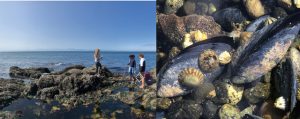Summer Research Internship
Applications will open on December 10, 2020 and close on February 15, 2021. This is an evolving list of mentors and projects, and new entries may be added prior to the opening date; be sure to check back here before submitting an application!
1. Kelp Bed Communities in the Salish Sea: the Influence of Biotic and Abiotic Factors
Dr. Katie Dobkowski, Bates College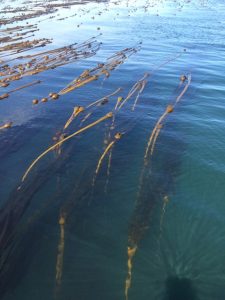
Dr. Katie Dobkowski is a marine community ecologist and especially focuses on foundation species such bull kelp (Nereocystis luetkeana). Nereocystis is an annual kelp species that provides the bulk of the complex three-dimensional habitat space in rocky subtidal habitats of the San Juan Islands and elsewhere in Washington State.
There are a variety of potential summer projects that focus on investigating biotic and abiotic factors influencing bull kelp across their complicated life history using a combination of lab and field work. Topics of interest include Northern kelp crab (Pugettia producta) and graceful kelp crab (Pugettia gracilis) feeding preferences (in the lab) and distribution and abundance (in the field, intertidal, snorkel or SCUBA surveys); contribution of P. producta feces to detrital food webs (in the lab, using field-collected intertidal copepod Tigriopus californicus); effect of intraspecific and interspecific competition with invasive Sargassum muticum on growth of juvenile N. luetkeana (in the field, using transplant and/or removal experiments); and the effects of changing ocean conditions, such as temperature, on invertebrate feeding rates (urchins, kelp crabs).
Subtidal data collection using SCUBA may possible for a student who is already a trained scientific diver at an AAUS member institution, but diving is NOT a requirement for any of the projects. A better understanding of the dynamics and interactions of N. luetkeana beds in the Salish Sea is crucial not only because they create valuable habitat for economically and ecologically important species, but also to inform management decisions and restoration efforts in a changing ocean.
2. Bull Kelp Multiple Stressors: Salinity & Temperature in the Salish Sea
Dr. Emily Carrington, University of Washington
Robin Fales, University of Washington
Kindall Murie, University of Washington
Kelps are important foundation species, providing physical habitat and food for a diversity of other organisms within the forests they create. Bull kelp (Nereocystis) forests are declining along the US West Coast and the causes of declines in the Salish Sea are unknown. The Salish Sea has multiple freshwater inputs which can expose kelps seasonally to warmer, lower salinity water. With snow melt increasing due to anthropogenic climate change, freshwater inputs to the Salish Sea may be greater in the future. We are interested in how the multiple stressors of temperature and salinity impact bull kelp physiology.
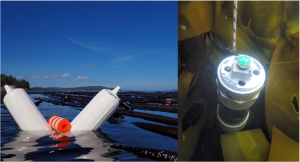 This project will include both laboratory and field work, such as measuring temperature and salinity fluctuations within and among kelp beds, quantifying kelp growth across an abiotic gradient and assessing the photosynthetic response of kelp to multiple stressors. For a student who is a certified AAUS scientific diver, there is the opportunity to take part in SCUBA surveys and sensor deployment in the field. However, diving certification is NOT required to be considered for this project. Students who are comfortable snorkeling, kayaking, or have boat experience are encouraged to apply.
This project will include both laboratory and field work, such as measuring temperature and salinity fluctuations within and among kelp beds, quantifying kelp growth across an abiotic gradient and assessing the photosynthetic response of kelp to multiple stressors. For a student who is a certified AAUS scientific diver, there is the opportunity to take part in SCUBA surveys and sensor deployment in the field. However, diving certification is NOT required to be considered for this project. Students who are comfortable snorkeling, kayaking, or have boat experience are encouraged to apply.
3. The Effects of Ocean Change on Shell-Boring Worms
Dr. Andrew David, Clarkson University
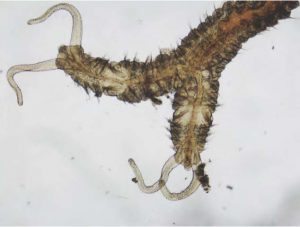 Ocean environmental change is expected to negatively impact marine life and is of particular economic concern to shellfish farms around the world. While there have been numerous studies that have investigated the effects of changing conditions on commercial bivalves and gastropods, there has never been an attempt to quantify its effects on their symbionts, specifically shell-boring polychaetes. In this study we will utilize the facilities at Friday Harbor Laboratories to investigate the effects of salinity and temperature on both the physiological performance and larval development of the polychaete Boccardia proboscidea – a pest of commercially reared abalone in southern Africa. Boccardia proboscidea is invasive to South Africa and based on genetic studies, the species originated from the Pacific Northwest. This research will therefore allow us to investigate how a climate change stressor affects a shellfish pest in its native habitat. In particular, we will use the worm’s regenerative capabilities as a proxy for physiological performance and will assess early life history parameters such larval growth, survival, developmental rate and larval size at hatching.
Ocean environmental change is expected to negatively impact marine life and is of particular economic concern to shellfish farms around the world. While there have been numerous studies that have investigated the effects of changing conditions on commercial bivalves and gastropods, there has never been an attempt to quantify its effects on their symbionts, specifically shell-boring polychaetes. In this study we will utilize the facilities at Friday Harbor Laboratories to investigate the effects of salinity and temperature on both the physiological performance and larval development of the polychaete Boccardia proboscidea – a pest of commercially reared abalone in southern Africa. Boccardia proboscidea is invasive to South Africa and based on genetic studies, the species originated from the Pacific Northwest. This research will therefore allow us to investigate how a climate change stressor affects a shellfish pest in its native habitat. In particular, we will use the worm’s regenerative capabilities as a proxy for physiological performance and will assess early life history parameters such larval growth, survival, developmental rate and larval size at hatching.
4. Chasing Molgula Tails: the Molecular Basis of the Evolution of Larval Tail Loss in Tail-less Ascidians
Dr. Billie J. Swalla, University of Washington
Ascidians are invertebrate chordates that are closely related to chordates and have all of the chordate features, including a notochord, pharyngeal slits, a dorsal nerve and a muscular, postnatal tail. We are interested in the gene networks that determine different tissues in ascidian embryos, in order to understand how chordates evolved their unique body plan.
5. Biomechanics of Sea Urchin Spines
Dr. Stephanie Crofts, College of the Holy Cross
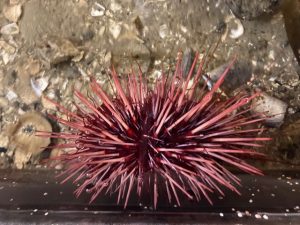 I’m interested in looking at the biomechanics of sea urchin spines and how they are used. I’m hoping to quantify and compare spine performance between the three most readily obtainable species of sea urchins at FHL. My goal is for students to collect data on the surface structure of spines, puncture and anchoring efficiency of spines, and/or bending strength of spines from all three species. I am hoping to correlate these measures to urchin behavior, such as how likely a species is to use spines to wedge themselves into a crevasse.
I’m interested in looking at the biomechanics of sea urchin spines and how they are used. I’m hoping to quantify and compare spine performance between the three most readily obtainable species of sea urchins at FHL. My goal is for students to collect data on the surface structure of spines, puncture and anchoring efficiency of spines, and/or bending strength of spines from all three species. I am hoping to correlate these measures to urchin behavior, such as how likely a species is to use spines to wedge themselves into a crevasse.
6. Diversity of Teeth in NW Pacific Fishes
Dr. Gareth Fraser, University of Florida
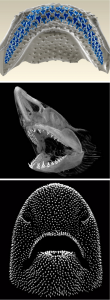 Teeth are incredibly diverse craniofacial structures in vertebrates. Fishes have an immense variety of dentitions, tooth shapes, dental location and tooth replacement mechanisms. This project aims to address the diversity of teeth in the fishes of the NW Pacific, taking particular advantage of the wealth of diversity around the San Juan Islands, and can include many members of the wider fish clade from jawless fishes (Cyclostomes; hagfish and lampreys), cartilaginous fishes (Chondrichthyes; sharks, rays and chimeras), to the bony fishes (Osteichthyes). For this project we aim to use modern (3D imaging/CT) and classical techniques (histology/clearing/live staining) to compare the naturally diverse marine fauna to established models to most effectively address questions in evolutionary developmental biology. This project will uncover novel aspects of dental diversity in understudied fishes collected at Friday Harbor Laboratories. The waterways of the NW Pacific are wonderfully productive and a vast variety of fishes can be collected and studied for this project.
Teeth are incredibly diverse craniofacial structures in vertebrates. Fishes have an immense variety of dentitions, tooth shapes, dental location and tooth replacement mechanisms. This project aims to address the diversity of teeth in the fishes of the NW Pacific, taking particular advantage of the wealth of diversity around the San Juan Islands, and can include many members of the wider fish clade from jawless fishes (Cyclostomes; hagfish and lampreys), cartilaginous fishes (Chondrichthyes; sharks, rays and chimeras), to the bony fishes (Osteichthyes). For this project we aim to use modern (3D imaging/CT) and classical techniques (histology/clearing/live staining) to compare the naturally diverse marine fauna to established models to most effectively address questions in evolutionary developmental biology. This project will uncover novel aspects of dental diversity in understudied fishes collected at Friday Harbor Laboratories. The waterways of the NW Pacific are wonderfully productive and a vast variety of fishes can be collected and studied for this project.
7. Biomechanics of Terrestrial Locomotion in Tidepool Sculpins
Dr. Michael Minicozzi, Minnesota State University Mankato &
Dr. Alice Gibb, Northern Arizona University
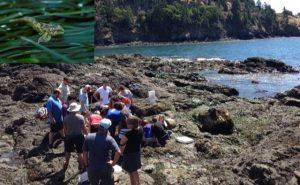 Tidepool fishes are an excellent system in which to study the transition from water to land, a seminal event in vertebrate history. The student working on this project will investigate the kinematics of terrestrial behaviors locomotor behaviors in Tidepool sculpins through high speed cinematography and assess the material properties of the appendages associated with the fish’s terrestrial movements with a variety of techniques. Methods for studying material properties include histology (scanning electron microscopy and traditional sectioning and staining) CT scanning, and material tension/compression tests. Through these studies, we can address the overarching evolutionary question: what are the key anatomical modifications necessary for vertebrate animals to move out of the water and onto the land?
Tidepool fishes are an excellent system in which to study the transition from water to land, a seminal event in vertebrate history. The student working on this project will investigate the kinematics of terrestrial behaviors locomotor behaviors in Tidepool sculpins through high speed cinematography and assess the material properties of the appendages associated with the fish’s terrestrial movements with a variety of techniques. Methods for studying material properties include histology (scanning electron microscopy and traditional sectioning and staining) CT scanning, and material tension/compression tests. Through these studies, we can address the overarching evolutionary question: what are the key anatomical modifications necessary for vertebrate animals to move out of the water and onto the land?
8. Behavioral Flexibility in Amphibious Fishes
Dr. Emily Standen, University of Ottawa
Dr. Cassandra Donatelli, University of Ottawa
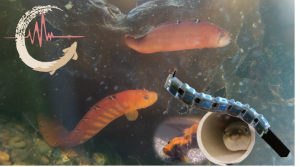 Amphibious fishes, or fishes that can survive both in water and on land, have incredible ability to change their locomotor strategies to match their environments. They can move effectively through the water, in shallow pools, and even over rough and gravely terrain. Fish’s ability to change locomotor strategies quickly is the envy of roboticists trying to design machines that can navigate different environments. This project will investigate the role of the fish’s morphology (internal and external) on their behavioral flexibility. For this project, we will measure swimming and walking (or slithering) kinematics in a range of amphibious fishes such as Pricklebacks, Sculpins, Midshipmen, and Clingfish using high speed video. We will also use force plates to measure the different forces the fish experience moving along the ground in the water vs moving on land. Finally, we will use CT scans to quantify the skeletal morphology of our different species. This project will help us understand how body shape influences behavioral flexibility in difficult terrain and the data we collect will help inform roboticists building bio-inspired devices
Amphibious fishes, or fishes that can survive both in water and on land, have incredible ability to change their locomotor strategies to match their environments. They can move effectively through the water, in shallow pools, and even over rough and gravely terrain. Fish’s ability to change locomotor strategies quickly is the envy of roboticists trying to design machines that can navigate different environments. This project will investigate the role of the fish’s morphology (internal and external) on their behavioral flexibility. For this project, we will measure swimming and walking (or slithering) kinematics in a range of amphibious fishes such as Pricklebacks, Sculpins, Midshipmen, and Clingfish using high speed video. We will also use force plates to measure the different forces the fish experience moving along the ground in the water vs moving on land. Finally, we will use CT scans to quantify the skeletal morphology of our different species. This project will help us understand how body shape influences behavioral flexibility in difficult terrain and the data we collect will help inform roboticists building bio-inspired devices
9. Functional Morphology of Fish Burial
Dr. Stacy Farina, Howard University
Kyra Amacker, Howard University
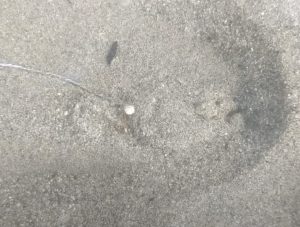 Some fish species are able to rapidly bury themselves beneath the sediment, to hide from predators. There are many anatomical and behavioral adaptations for burial, and during summer 2021, we will study the use of opercular jetting (shooting water out of gill openings) to fluidize sand during burial. Potential projects include constructing and testing a robotic model of opercular jetting, measuring aspects of jetting behavior in living fish species, and comparing jetting across species in an evolutionary context.
Some fish species are able to rapidly bury themselves beneath the sediment, to hide from predators. There are many anatomical and behavioral adaptations for burial, and during summer 2021, we will study the use of opercular jetting (shooting water out of gill openings) to fluidize sand during burial. Potential projects include constructing and testing a robotic model of opercular jetting, measuring aspects of jetting behavior in living fish species, and comparing jetting across species in an evolutionary context.
10. Ventilation in Small Sharks: Physiology and Functional Morphology
Dr. Lara Ferry, Arizona State University &
Sarah Handy, Arizona State University
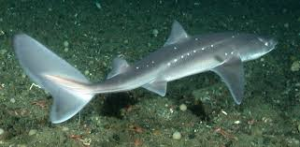 A common misconception about sharks is that they need to be swimming all the time in order to move water over the gills for obtaining oxygen. This mode of ventilation, called ‘ram’ ventilation, may be used by a few large sharks such as the famous Great White, but not as much by benthic species of sharks that spend much of their life on the seafloor. In fact, nearly all species use a combination of both ram and ‘pump’ ventilation, but the conditions under which either may be used are not well understood. To investigate, mentees will gather information about shark ventilation from live sharks, such as the Pacific Spiny Dogfish found in the Salish Sea around Friday Harbor Labs, in both the swimming and resting state, using tools such as pressure transduction and video data collection. Mentees may also choose to participate in anatomical dissections to investigate and image the anatomy underlying ventilation.
A common misconception about sharks is that they need to be swimming all the time in order to move water over the gills for obtaining oxygen. This mode of ventilation, called ‘ram’ ventilation, may be used by a few large sharks such as the famous Great White, but not as much by benthic species of sharks that spend much of their life on the seafloor. In fact, nearly all species use a combination of both ram and ‘pump’ ventilation, but the conditions under which either may be used are not well understood. To investigate, mentees will gather information about shark ventilation from live sharks, such as the Pacific Spiny Dogfish found in the Salish Sea around Friday Harbor Labs, in both the swimming and resting state, using tools such as pressure transduction and video data collection. Mentees may also choose to participate in anatomical dissections to investigate and image the anatomy underlying ventilation.
11. The Pace of Life for Deep-Sea Fishes
Dr. Mackenzie Gerringer, The State University of New York (SUNY) Geneseo
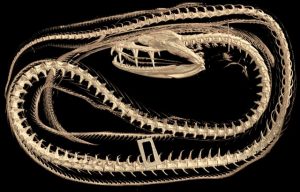 What does it take to survive and thrive in the deep oceans? Deep-sea animals have a reputation for being slow-growing and long-lived, with lower metabolic rates than their shallow-water counterparts. However, direct measurements of metabolism and activity are challenging at extreme depths. Are deep-sea organisms actually slow and sluggish? In this project, we will explore the pace of life in the deep ocean. We will be analyzing video and CT scans of deep-sea fishes. We will compare these deep-sea fishes to shallow-water relatives that we will work with in the lab to investigate trends in activity with increasing habitat depth. Those interested in deep-sea adaptation, physiological time, and the intersection of physiology, ecology, and biomechanics are especially encouraged to apply.
What does it take to survive and thrive in the deep oceans? Deep-sea animals have a reputation for being slow-growing and long-lived, with lower metabolic rates than their shallow-water counterparts. However, direct measurements of metabolism and activity are challenging at extreme depths. Are deep-sea organisms actually slow and sluggish? In this project, we will explore the pace of life in the deep ocean. We will be analyzing video and CT scans of deep-sea fishes. We will compare these deep-sea fishes to shallow-water relatives that we will work with in the lab to investigate trends in activity with increasing habitat depth. Those interested in deep-sea adaptation, physiological time, and the intersection of physiology, ecology, and biomechanics are especially encouraged to apply.
12. Animal Behavior and how it Intersects with Conservation Biology, Ecology, and Evolutionary Biology
Dr. Amy Cook, The Evergreen State College
 One of the greatest challenges animal behaviorists face is observing their subjects in the wild. However, San Juan Island offers opportunities to make detailed observations of the behavior of a variety of animals in the field with relative ease. My mentees will learn the techniques of studying behavior in the field including how to describe behaviors, sampling and recording methodologies, and data collection and analysis. Once they are comfortable with the methodology, my mentees can apply the field behavior techniques they learned to one of the following projects – foraging behavior in Pigeon Guillemots, rabbit behavior in the grasslands of San Juan Island National Historical Park, or the behavior of juvenile tidepool sculpins (Oligocottus maculotus) in intertidal pools – or propose a project of their own. Animal behavior intersects with conservation biology, ecology, and evolutionary biology and we will discuss these connections in regular research seminars. On San Juan Island, the interaction between human behavior and the behavior of other animals is an important factor in many of our study systems. We will talk with rangers at both the National Historical Park and Lime Kiln Point State Park (the primary site for watching orca whales on San Juan Island) to learn more about those interactions. This project will benefit mentees interested in pursuing a careers or advanced study in animal behavior, field ecology, or conservation biology.
One of the greatest challenges animal behaviorists face is observing their subjects in the wild. However, San Juan Island offers opportunities to make detailed observations of the behavior of a variety of animals in the field with relative ease. My mentees will learn the techniques of studying behavior in the field including how to describe behaviors, sampling and recording methodologies, and data collection and analysis. Once they are comfortable with the methodology, my mentees can apply the field behavior techniques they learned to one of the following projects – foraging behavior in Pigeon Guillemots, rabbit behavior in the grasslands of San Juan Island National Historical Park, or the behavior of juvenile tidepool sculpins (Oligocottus maculotus) in intertidal pools – or propose a project of their own. Animal behavior intersects with conservation biology, ecology, and evolutionary biology and we will discuss these connections in regular research seminars. On San Juan Island, the interaction between human behavior and the behavior of other animals is an important factor in many of our study systems. We will talk with rangers at both the National Historical Park and Lime Kiln Point State Park (the primary site for watching orca whales on San Juan Island) to learn more about those interactions. This project will benefit mentees interested in pursuing a careers or advanced study in animal behavior, field ecology, or conservation biology.
13. Thermal Stress in Mussels: the Effects of Stable vs. Fluctuating Temperatures
Dr. Michael Nishizaki, Carleton College
In this age of climate change, the biological impacts of rising temperatures have been documented in terrestrial, freshwater, and marine ecosystems around the world. These effects are especially evident on intertidal shores, where organisms commonly live near their thermal limits. Although temperature clearly impacts the ecology and physiology of many benthic marine organisms, most experiments have been conducted under stable thermal conditions. While these data are informative, they do not approximate the type of thermal variation that organisms face under natural conditions. For example, mussels (Mytilus trossulus) on San Juan Island can experience rapidly fluctuating temperatures while submerged in tidepools and shallow waters. This REU project will involve monitoring temperature fluctuations in natural mussel habitats and using those temperatures in lab experiments to measure physiological responses of mussels (e.g., changes in respiration rate, gene expression).
14. Mussel Behavior & Physiology in Dynamic Coastal Environments
Dr. Emily Carrington, University of Washington
Dr. Matt Reidenbach, University of Virginia
Jack Litle, University of Washington
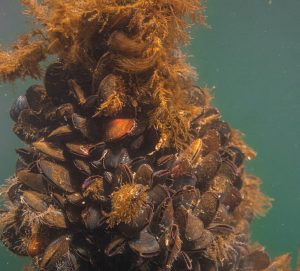 This project investigates how dense aggregations of marine organisms alter their local water chemistry, and how these microscale alterations feedback to affect the organisms’ interactions in dynamic coastal ecosystems. The research focuses on bivalve mussels, foundation species that form dense ‘beds’ typically known for facilitating other species by ameliorating harsh flow conditions. The ability to aggregate can become a liability, however, if flow is not sufficient to flush the interstitial spaces and steep, metabolically-driven concentration gradients develop. We will use a suite of field and laboratory techniques to investigate how various mussel behaviors (such as filtration, gaping and byssal thread production) respond to and/or create corrosive chemical microclimates (such as low oxygen or low pH). The research addresses a global societal concern, the impact of anthropogenic climate change on coastal marine ecosystems, and has potential applications to aquaculture by informing adaptation strategies to “future-proof” mussel farms in the face of climate change.
This project investigates how dense aggregations of marine organisms alter their local water chemistry, and how these microscale alterations feedback to affect the organisms’ interactions in dynamic coastal ecosystems. The research focuses on bivalve mussels, foundation species that form dense ‘beds’ typically known for facilitating other species by ameliorating harsh flow conditions. The ability to aggregate can become a liability, however, if flow is not sufficient to flush the interstitial spaces and steep, metabolically-driven concentration gradients develop. We will use a suite of field and laboratory techniques to investigate how various mussel behaviors (such as filtration, gaping and byssal thread production) respond to and/or create corrosive chemical microclimates (such as low oxygen or low pH). The research addresses a global societal concern, the impact of anthropogenic climate change on coastal marine ecosystems, and has potential applications to aquaculture by informing adaptation strategies to “future-proof” mussel farms in the face of climate change.
15. Plankton Ecology: an Analysis of Data from the FHL Ocean Observatory
Dr. Kirk Sato, University of Washington
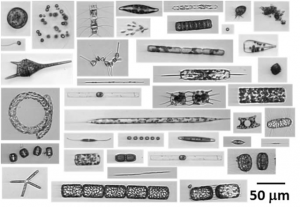 We will work with a multivariate biogeochemical dataset to study the plankton ecology at FHL. This project would include a quantitative analysis of oceanographic and biological microplankton data local to FHL. The student will be trained in all aspects of the FHL Ocean Observatory, including but not limited to sensor maintenance, data management, data analysis, taxonomic identification of key microplanktonic groups (size range from 10-150 micrometers) like diatoms, dinoflagellates, ciliates and other potential Harmful Algae. In addition, the student will gain valuable experience working with Python, R, and other software programs.
We will work with a multivariate biogeochemical dataset to study the plankton ecology at FHL. This project would include a quantitative analysis of oceanographic and biological microplankton data local to FHL. The student will be trained in all aspects of the FHL Ocean Observatory, including but not limited to sensor maintenance, data management, data analysis, taxonomic identification of key microplanktonic groups (size range from 10-150 micrometers) like diatoms, dinoflagellates, ciliates and other potential Harmful Algae. In addition, the student will gain valuable experience working with Python, R, and other software programs.
16. Eelgrass Seeding & Transportation Dynamics in Varying Subtrates
Dr. Andrea Ogston, University of Washington
Dr. Sandy Wyllie-Echeverria, University of Washington
The relationships between seabed characteristics, tidal flows and seed transport and entrapment are important considerations when selecting sites to restore Zostera marina (eelgrass) using seeds or to evaluate seeding success. In the Pacific Northwest, which includes the Salish Sea, eelgrass grows in substrate types ranging from “pure soft mud” to “pure soft sand” with optimum conditions related to “mixed sand and mud”. An objective of this REU project is to experimentally determine the transport and settlement dynamics of eelgrass seeds within this range of seabed environments. This will aid in selection of appropriate sites for restoring eelgrass with seeds in the Salish Sea. Previous studies suggest that finer grained sediments influence the success of eelgrass seeding both positively and negatively. Cohesion associate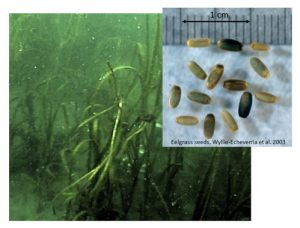 d with muddy seabeds can potentially entrap seeds, and this positive feature both prevents seed transport across the sediment surface and promotes settling, germination and seedling growth. However, a negative feature of finest grained sediments is that they may be more easily resuspended by currents and waves, which reduces water clarity and potentially decreases the suitability of a site for seedling survival. However, ripples are more likely to develop in sandy seabeds and could also act as seed traps without the associated bed resuspension. This REU project will consist of flume experiments using sediment obtained from local eelgrass restoration areas and “mimic” seeds of variable sizes. Sediment grain size and bedform characteristics will be measured under typical tidal flow speeds. Mimic seeds will be tracked using video techniques, and suspended sediment monitored with an in situ sensor. These experiments will test the relationship between seabed characteristics, seed transport, seed entrapment and potential light attenuation under a range of tidal flows. Results will help inform which seabed types/tidal flows are best suited for reseeding efforts.
d with muddy seabeds can potentially entrap seeds, and this positive feature both prevents seed transport across the sediment surface and promotes settling, germination and seedling growth. However, a negative feature of finest grained sediments is that they may be more easily resuspended by currents and waves, which reduces water clarity and potentially decreases the suitability of a site for seedling survival. However, ripples are more likely to develop in sandy seabeds and could also act as seed traps without the associated bed resuspension. This REU project will consist of flume experiments using sediment obtained from local eelgrass restoration areas and “mimic” seeds of variable sizes. Sediment grain size and bedform characteristics will be measured under typical tidal flow speeds. Mimic seeds will be tracked using video techniques, and suspended sediment monitored with an in situ sensor. These experiments will test the relationship between seabed characteristics, seed transport, seed entrapment and potential light attenuation under a range of tidal flows. Results will help inform which seabed types/tidal flows are best suited for reseeding efforts.
17. Larval Biology: Growing Up in a Sea of Change
Dr. Karen Chan, Swarthmore College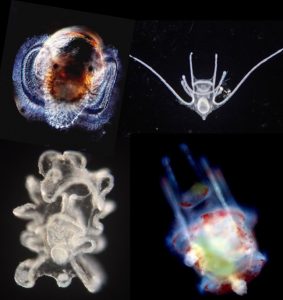
Many marine organisms have complex life history and rely on their planktonic larval stage for dispersal. Our work explores how larvae of marine invertebrates (baby sea urchins and snails) are affected by environmental factors related to climate change and how they navigate the water column. We combine physiological measurements with video motion analysis to assess whole-organism performance and determine the population-level impacts.
